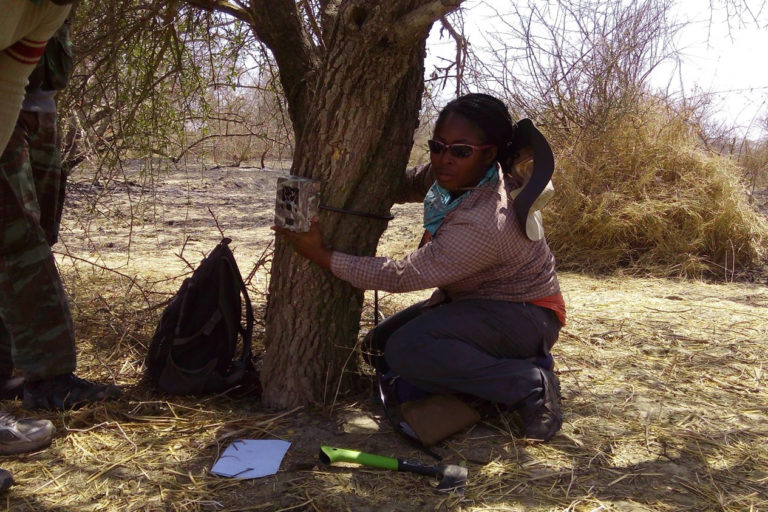- The first camera study of wildlife in Burkina Faso and Niger has shown that the main human activities in the region’s largest protected area are gathering resources and grazing livestock.
- Poaching remains a threat, but it occurs less frequently than other human pressures on the region’s wildlife.
- The findings suggest possible changes in management strategies for three national parks in West Africa.
Protected lands in the tropics are often managed to curtail poaching, creating a refuge for vulnerable wildlife that face risks of extinction. However, a new study in West Africa’s largest protected land complex offers a snapshot of human and wildlife activities within three national parks — and poaching played a smaller role than other ways humans used the land.

In the first camera survey in Burkina Faso and Niger, researchers analyzed more than one million images from motion-detecting cameras placed throughout the W-Arly-Pendjari (WAP) complex, spanning about 6,800 square kilometers (2,600 square miles). Their findings, published recently in Conservation Letters, suggest that a sole focus on poaching creates blind spots in management.
“That’s the dominant narrative when we talk about human-wildlife conflict, especially in the tropics,” said Nyeema Harris, an ecologist at the University of Michigan and lead author of the study. “And that isn’t what we found.”

The images were taken by 119 cameras strapped to trees over three dry seasons (January to May), in three separate surveys starting in 2016. The team divided the study area into a grid of 10 kilometer by 10 kilometer (6.2 mile by 6.2 mile) cells, and placed a camera within 2 kilometers (1.2 miles) of each cell’s center. When triggered by movement, each camera snapped a rapid series of three to five photos.
Back at the University of Michigan, Harris employed a “small army” of students to analyze the photos and categorize them based on the type of wildlife or human activity they captured. Images of wild mammals fell into four groups: primates, ungulates (hooved mammals), carnivores and small mammals. The team also classified people that triggered the cameras, based on their activity. For instance, people carrying rifles were assumed to be poaching; others carrying fruit were considered gathering. When the photos showed livestock or other domesticated animals, researchers classified that as an indirect human activity.
The wildlife in an area didn’t vary much if humans were also present. Instead, the photos showed that livestock caused the greatest wildlife response. This was especially true for ungulates, such as the common warthog (Phacochoerus africanus) and African bush elephant (Loxodonta africana). Their absence in areas trafficked by livestock could be due to the two groups of animals competing over resources, the researchers noted.
Of the 427 camera triggers caused by humans or domesticated animals, just 11 percent showed poaching. Grazing livestock and people gathering resources were the two greatest human-related activities, accounting for 38 percent and 21 percent of the total, respectively.

Rachel Buxton, a biologist at Carleton University in Ottawa, Canada, who was not involved with the study, agrees that the threat of poaching shouldn’t drive all land-management decisions.
“Managing for coexistence is really the way to go, and something that these sorts of camera trap studies can facilitate,” she said. Buxton conducted a similar survey monitoring how noise and human activity affected wildlife near a Colorado oil field.
Camera surveys do have some limitations, including human interference, Buxton noted. Twelve of the researchers’ cameras were stolen during the project, and Buxton pointed out they could have been removed by poachers to hide their activities. The unknown number of images, and the human pressures they captured, represent a missing puzzle piece of unknown size and shape.
However, Harris said the camera theft didn’t occur “at a rate that would compromise our interpretation or quality…of the data.”

The diverse set of images collected by the team call for more “inclusive conservation” in the parks, said Harris. Instead of a singular focus on poaching, land managers should acknowledge that activities like cattle grazing happen — and then work with residents to lessen their impact on native wildlife.
“Some of those resources have direct benefits for supporting livelihoods,” she said. “Not all human activity is bad.”
CITATION:
Harris, N. C., Mills, K. L., Harissou, Y., Hema, E. M., Gnoumou, I. T., VanZoeren, J., … & Doamba, B. (2019). First camera survey in Burkina Faso and Niger reveals human pressures on mammal communities within the largest protected area complex in West Africa. Conservation Letters, 12(5). https://doi.org/10.1111/conl.12667
Jerimiah Oetting (@joetting13) is a graduate student in the Science Communication Program at the University of California, Santa Cruz. Other Mongabay stories produced by UCSC students can be found here at https://news.mongabay.com/list/ucsc/.